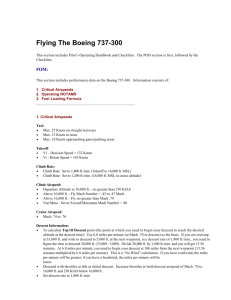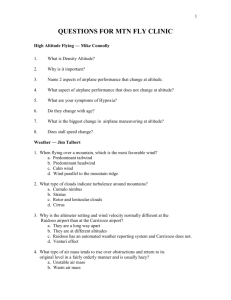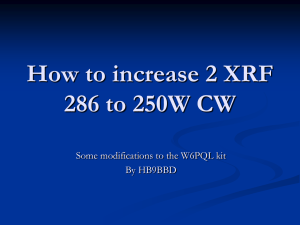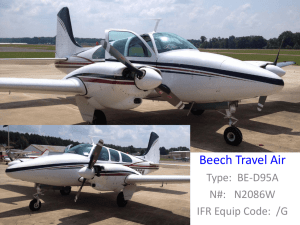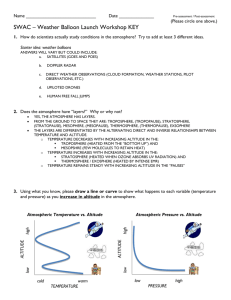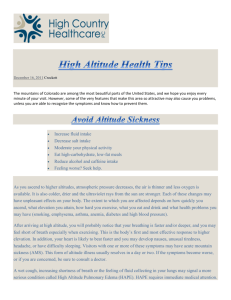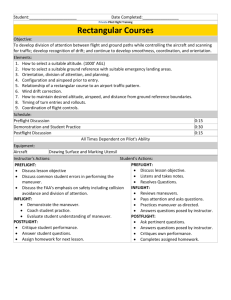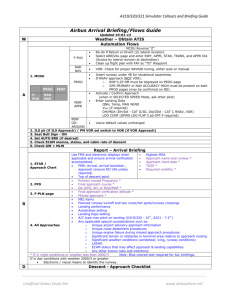PPLManeuvers
advertisement
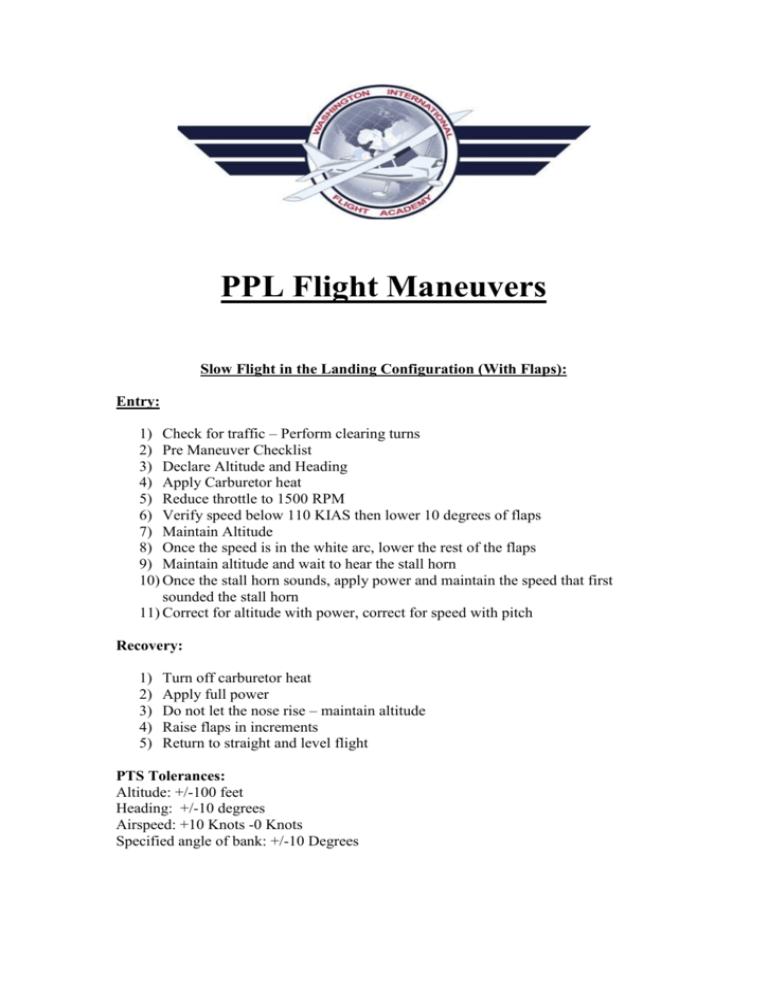
PPL Flight Maneuvers Slow Flight in the Landing Configuration (With Flaps): Entry: 1) Check for traffic – Perform clearing turns 2) Pre Maneuver Checklist 3) Declare Altitude and Heading 4) Apply Carburetor heat 5) Reduce throttle to 1500 RPM 6) Verify speed below 110 KIAS then lower 10 degrees of flaps 7) Maintain Altitude 8) Once the speed is in the white arc, lower the rest of the flaps 9) Maintain altitude and wait to hear the stall horn 10) Once the stall horn sounds, apply power and maintain the speed that first sounded the stall horn 11) Correct for altitude with power, correct for speed with pitch Recovery: 1) 2) 3) 4) 5) Turn off carburetor heat Apply full power Do not let the nose rise – maintain altitude Raise flaps in increments Return to straight and level flight PTS Tolerances: Altitude: +/-100 feet Heading: +/-10 degrees Airspeed: +10 Knots -0 Knots Specified angle of bank: +/-10 Degrees Slow Flight in the Take-Off Configuration (Without Flaps): Entry: Check for traffic – Perform clearing turns Pre Maneuver Checklist Declare Altitude and Heading Apply Carburetor heat Reduce throttle to 1500 RPM Maintain Altitude Maintain altitude and wait to hear the stall horn Once the stall horn sounds, apply power and maintain the speed that first sounded the stall horn 9) Correct for altitude with power, correct for speed with pitch 1) 2) 3) 4) 5) 6) 7) 8) Recovery: 1) 2) 3) 4) Turn off carburetor heat Apply full power Do not let the nose rise – maintain altitude Return to straight and level flight PTS Tolerances: Altitude: +/-100 feet Heading: +/-10 degrees Airspeed: +10 Knots -0 Knots Specified angle of bank: +/-10 Degrees Power Off Stall (Landing Configuration): Entry: 1) Check for traffic – perform clearing turns 2) Pre Maneuver Checklist 3) Declare Altitude and Heading 4) Apply Carburetor heat 5) Reduce throttle to 1500 RPM 6) Lower 10 degrees of flaps 7) Maintain Altitude 8) Once the speed is in the white arc, lower the rest of the flaps 9) At 65 knots, establish descent 10) Power Idle and establish flare attitude 11) Maintain altitude with nose and induce stall Recovery: 1) Release back pressure on yoke and lower nose 2) Turn off Carburetor heat 3) Apply full throttle 4) Raise one setting of flaps ( to 20 degrees) 5) Bring nose to climb pitch 6) When gaining airspeed raise another setting of flaps ( to 10 degrees) 7) Once established with positive rate of climb raise the rest of the flaps 8) Return to straight and level flight PTS Tolerances: Heading: +/-10 degrees Airspeed: +10 Knots -0 Knots Specified angle of bank: +/-20 Degrees (+/- 10 degrees when in turning flight) Power On Stall (Take Off Configuration): Entry: 1) Check for traffic – perform clearing turns 2) Pre Maneuver Checklist 3) Declare Altitude and Heading 4) Apply Carburetor heat 5) Reduce throttle to 1500 RPM 6) Maintain Altitude 7) At 55 knots, turn off carburetor heat 8) Apply 65% power (2100-2200 RPM) 9) Raise nose to induce stall 10) Keep wings level and ball centered Recovery: 1) 2) 3) 4) 5) 6) Release back pressure on yoke and lower nose Apply full power Gain airspeed Bring nose to climb pitch Once established with positive rate of climb Return to straight and level flight Return to initial altitude PTS Tolerances: Heading: +/-10 degrees Airspeed: +10 Knots -0 Knots Specified angle of bank: +/-20 Degrees (+/- 10 degrees when in turning flight) Steep Turns: 1) Check for traffic – perform clearing turns 2) Pre-Maneuver checklist 3) Declare altitude and heading 4) Establish safe airspeed at or below Va 5) Set power to cruise at 2200 RPM 6) Establish a bank angle of 45 degrees 7) Slightly Apply power (roughly 100 RPM) 8) Maintain altitude (bank angle and back pressure) 9) 20 degrees before your selected heading begin to roll out 10) Return to straight and level flight 11) Begin turn to opposite direction and repeat steps 3 thru 8 PTS Tolerances: Altitude: +/-100 feet Heading: +/-10 degrees Airspeed: +/- 10 Knots Specified angle of bank: +/-5 Degrees Turns Around A Point: Check for traffic – perform clearing turns Pre-Maneuver checklist Descend to an altitude at 1000 feet AGL Determine wind direction Choose reference point on the ground Maneuver aircraft to come abeam the point downwind 7) Enter the turn (left or right) around the Selected point 8) Compensate for wind drift using bank angle to maintain uniform radius around the point. (Refer to illustration) 9) Maintain altitude and complete 360 degree turn around the selected point. 10) Return to straight and level flight 1) 2) 3) 4) 5) 6) PTS Tolerances: Altitude: +/-100 feet Airspeed: +/- 10 Knots S-Turns: Check for traffic – perform clearing turns Pre-Maneuver checklist Descend to an altitude at 1000 feet AGL Determine wind direction Choose reference point on the ground Maneuver aircraft to cross road downwind Enter the turn (left or right) when crossing the road. 8) Compensate for wind drift using bank angle to cross the road at the 180 degree point with the wings level. (Refer to illustration) 9) As you cross the road, enter a turn in the opposite direction. 10) Compensate for wind drift using bank angle to cross the road at the road after the second 180 degree turn with wings level. (Refer to illustration) 11) Maintain altitude as you complete the two 180 degree turns. 12) Return to straight and level flight. 1) 2) 3) 4) 5) 6) 7) PTS Tolerances: Altitude: +/-100 feet Airspeed: +/- 10 Knots Rectangular Course: Check for traffic – perform clearing turns Pre-Maneuver checklist Descend to an altitude at 1000 feet AGL Determine wind direction Choose reference point on the ground Maneuver aircraft to enter the rectangular course on a 45 degree angle to the downwind segment. 7) When you turn to the crosswind segment, in order to compensate for wind drift, continue the turn beyond the 90 degree point, pointing the nose slightly into the wind. This technique is called” Crabbing”. (Refer to illustration) 8) When you turn to the upwind segment, your turn will be less than 90 degrees due to the crab angle you held during the crosswind segment. 9) When you reach the next crosswind segment, you should turn less than 90 degrees in order to “crab” the aircraft in to the wind to maintain a straight ground track. (refer to illustration) 10) Return to straight and level flight. 1) 2) 3) 4) 5) 6) PTS Tolerances: Altitude: +/-100 feet Airspeed: +/- 10 Knots Normal Approach and Landing: 1) Perform Before Landing Checklist 2) Abeam the approach the end of the runway apply Carb. heat, extend 10 degrees of flaps 3) Establish descent at 85KIAS 4) When the runway is 45 degrees behind you, turn to Base Leg 5) Verify speed within white arc and extend flaps to 20 degrees 6) Slow to descend at 75KIAS 7) Turn final and extend full flaps, maintain 65 KIAS 8) When aircraft is above the runway, reduce power smoothly to IDLE 9) At 10 feet above runway apply flare. Keep eyes focused on far end of runway. 10) After touchdown maintain centerline 11) Apply braking as needed PTS Tolerances: Airspeed: Maintain Vso x 1.3 (+10 / -5 Knots) Touch down within 400 feet of assigned spot on runway, with no drift and the airplanes longitudinal axis aligned with and over the runway centerline. Engine out: 12) Establish best glide speed – 65 knots 13) Select suitable landing site 14) Begin trouble shoot (Primer, Master switch, magnetos, circuit breakers, carb heat on, mixture full rich, throttle full open, fuel selector on both) 15) Try to start engine 16) Set transponder to 7700 and Com1 to 121.5 17) Declare Mayday 18) Secure aircraft (fuel selector off, mixture idle cut-off, throttle idle, all electric switches off, Master switch off AFTER you lower flaps for landing, tighten belts and open door) 19) Touch down as slow as possible 20) Apply braking. PTS Tolerances: Airspeed: +/- 10 Knots Short Field Take Off: (The following is for a Cessna 172N, Always refer to your POH for specific techniques) 1) 2) 3) 4) 5) 6) 7) 8) 9) Extend 10 Degrees of Flaps Utilize full length of runway Hold Brakes and Apply full power Release brakes and begin take off roll Hold Elevator in slight tail low position. Climb at Vx until clear of obstacles and at safe altitude Lower pitch angle and accelerate to Vy Retract flaps Continue normal climb PTS Tolerances: Airspeed: +10 / -5 Knots Short Field Landing: (The following is for a Cessna 172N, Always refer to your POH for specific techniques) 1) Perform Before Landing Checklist 2) Abeam the approach end of the runway extend 10 degrees of flaps 3) Establish descent at 80 KIAS 4) Turn Base and shoot for slight lower than normal approach 5) Extend flaps to 20 degrees and slow to descend at 70 KIAS 6) Turn final and extend full flaps, maintain 60 KIAS 7) After you clear the obstacle, reduce power to idle 8) Touch Down main wheels first 9) Apply heavy braking 10) Retract wing flaps and maintain back pressure on yoke to obtain optimum braking. PTS Tolerances: Airspeed: Maintain Vso x 1.3 (+10 / -5 KIAS) Touch Down within the 200 feet beyond a specified point on the runway with no side drift, minimum float, at minimum controllable airspeed and the airplanes longitudinal axis aligned with and over the runway centerline. Soft Field Take Off: (The following is for a Cessna 172N, Always refer to your POH for specific techniques) 1) Extend 10 Degrees of Flaps 2) sllt vpll n e uouHHpou lb uluF dloH 3) Utilize full length of runway if possible 4) Taxi on to runway with minimum braking 5) Holding full back pressure apply full power (no brakes) 6) Roll until aircraft lifts off from ground 7) Fly parallel to ground and accelerate, staying in ground effect, to Vx 8) Establish climb at Vx until clear of obstacles 9) When clear of obstacles and at safe altitude accelerate to Vy 10) Retract Flaps 11) Continue normal climb PTS Tolerances: Lifts off at lowest possible airspeed Airspeed: +10 / -5 Knots Soft Field Landing: (The following is for a Cessna 172N, Always refer to your POH for specific techniques) 1) 2) 3) 4) 5) 6) 7) Perform Before Landing Checklist Abeam the approach end of the runway extend 10 degrees of flaps Establish descent at 85KIAS Turn Base and shoot for normal approach Extend flaps to 20 degrees and slow to descend at 75KIAS Turn final and extend full flaps, maintain 65 KIAS Hold the aircraft roughly 2 feet off the ground as long as possible to dissapate forward speed. 8) Maintain slight power during touch down 9) Maintain back pressure on elevators 10) DO NOT APPLY BRAKING PTS Tolerances: Airspeed: Maintain approach speeds (+10 / -5 KIAS) Touch Down softly with no side drift, minimum float and at minimum controllable airspeed
